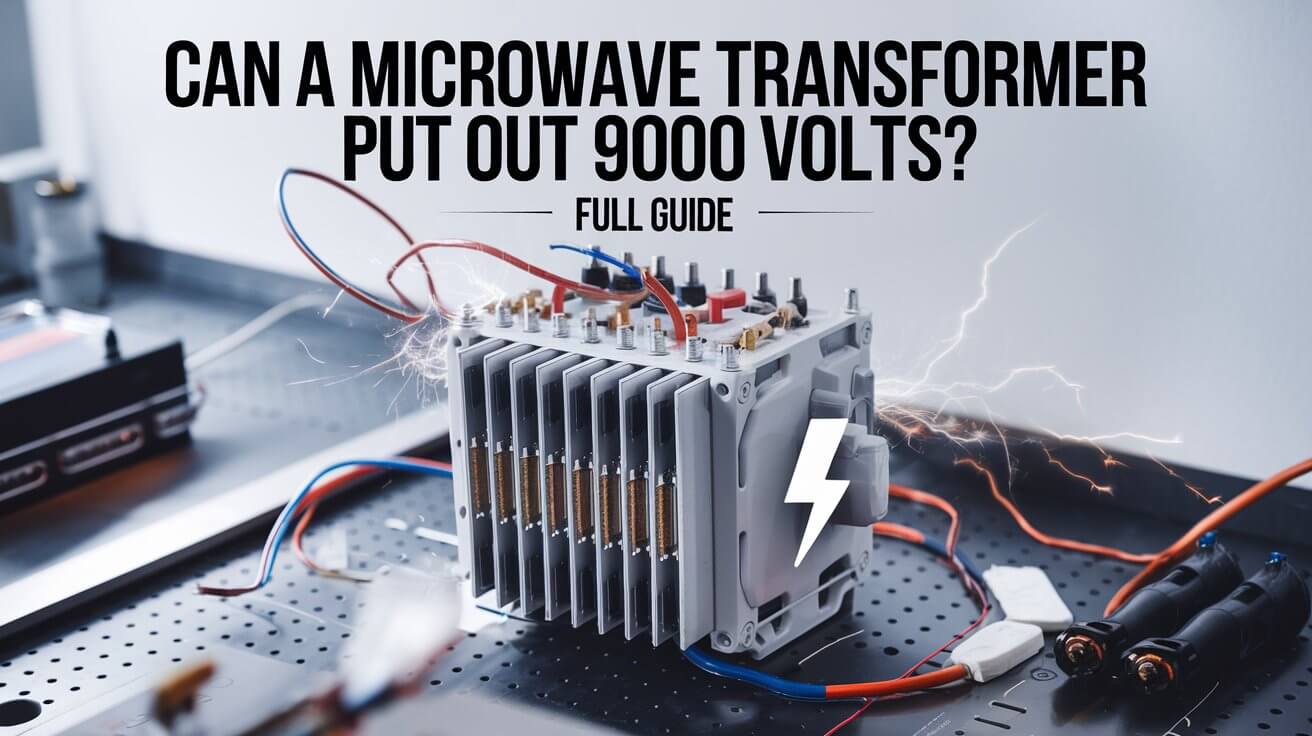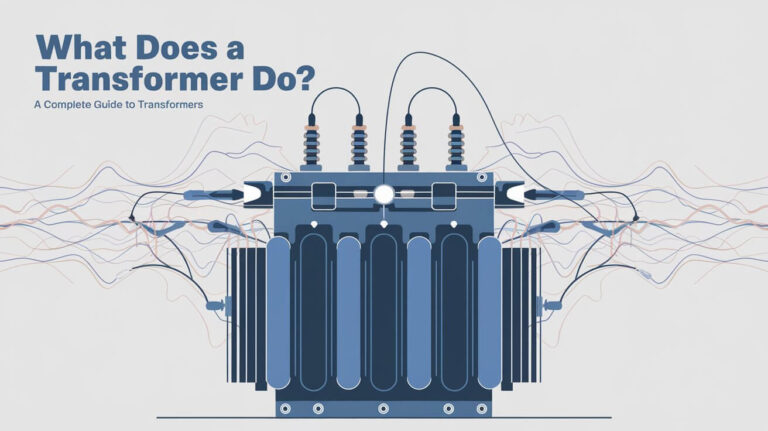Can a Microwave Transformer Put Out 9000 Volts? Full Guide

Microwave transformers are crucial components in microwave ovens, stepping up household voltage to power the magnetron that heats food. While standard microwave transformers typically output between 2,000 to 4,000 volts, many wonder whether they can achieve higher voltages, like 9,000 volts. In this article, we’ll explore the functioning of microwave transformers, their voltage output limits, and the possibility of achieving 9,000 volts, along with the potential risks and dangers involved.
How Does a Microwave Transformer Work?
Microwave transformers are designed to convert low-voltage AC power from your home (usually 120V or 240V) into much higher voltages. These transformers play a critical role in powering the magnetron, the device inside the microwave that generates microwave radiation to cook food. Understanding how these components function helps clarify their limitations and the possibility of reaching extreme voltages.
Stepping Up Voltage
The primary purpose of a microwave transformer is to step up the low household voltage to a high-voltage level needed by the magnetron. This is done through electromagnetic induction. A typical transformer has two main parts:
- Primary Winding: This is connected to the household power supply. When AC current flows through the primary winding, it creates a magnetic field.
- Secondary Winding: The magnetic field generated by the primary winding induces an electric current in the secondary winding, which has more turns than the primary coil, thereby creating a much higher voltage. This secondary winding outputs voltage high enough to power the magnetron, typically ranging from 2,000 to 4,000 volts.
The Role of the Magnetic Core
Microwave transformers also have a magnetic core made of ferromagnetic material (like iron), which enhances the efficiency of the voltage transformation. The core increases the strength of the magnetic field and helps concentrate it, ensuring that a small input current can generate the required high voltage output.
Current Flow and Magnetron Operation
Once the high voltage is produced, it’s fed into the magnetron. The magnetron then converts this electrical energy into microwave radiation, which cooks the food. Without the transformer, the magnetron wouldn’t receive the necessary power to function effectively.
What is the Standard Voltage Output of a Microwave Transformer?
Most microwave transformers are designed to output voltages between 2,000 to 4,000 volts. This range is essential for microwave oven operation, as the magnetron requires high voltages to generate microwaves efficiently.
The 4,000-volt upper limit is typical for most household microwave transformers because it meets the power requirements of the magnetron while balancing safety and efficiency. Manufacturers usually do not go beyond this voltage range for standard microwave ovens, as higher voltages can lead to overheating, insulation breakdowns, and other safety risks.
Why the Voltage Range Matters
The typical voltage output of 2,000 to 4,000 volts provides enough power to heat food effectively without causing damage to the magnetron or other components. If the transformer produced less voltage, the microwave wouldn’t work efficiently. On the other hand, producing higher voltages than necessary can be dangerous and lead to electrical failures.
Can a Microwave Transformer Output 9000 Volts?
The short answer is no, a standard microwave transformer cannot output 9,000 volts. Microwave transformers are designed with specific voltage limits in mind, and they are usually capped at around 4,000 volts for household microwaves.
Design Limitations
The primary design limitation is the number of windings in the secondary coil. To achieve 9,000 volts, the transformer would need significantly more turns in the secondary winding than it currently has. However, this would require a much larger and more complex transformer, which would be impractical for the size and design constraints of standard microwave ovens.
Microwave transformers are optimized for efficiency, size, and safety. Manufacturers carefully balance these factors, making a transformer that outputs 9,000 volts unnecessary and dangerous for typical microwave use.
Modifications and Custom Transformers
It is technically possible to modify a transformer to produce higher voltages, such as 9,000 volts, by increasing the number of windings in the secondary coil. However, this would not only be a complex process but also highly dangerous. Modifying a microwave transformer requires expertise in high-voltage electrical systems and safety precautions, as higher voltage outputs increase the risk of shock, fire, and equipment failure.
In certain industrial applications, custom transformers can be designed to output 9,000 volts or more. However, these transformers are built with different materials, cooling systems, and insulation to handle the increased voltage. They are not found in standard household microwaves.
What Happens if You Push a Transformer to Output Higher Voltages?
Attempting to modify a microwave transformer to output higher voltages like 9,000 volts can have serious consequences. Let’s explore what happens when transformers are pushed beyond their design limits.
Overloading and Overheating
When a transformer is forced to output higher voltages than it’s designed for, it can quickly overheat. The insulation around the windings may break down due to excess heat, leading to short circuits, sparks, or even fires. Overheating also reduces the transformer’s efficiency and shortens its lifespan significantly.
Insulation Breakdown
Transformers are built with insulation to separate the high-voltage components from the low-voltage ones. When a transformer is pushed beyond its voltage capacity, this insulation can break down, leading to dangerous electrical arcs, fires, or short circuits. This can pose serious risks to both the microwave and the person using it.
Arcing or Sparking
Overvoltage can cause electrical arcing within the transformer. Arcing occurs when the current jumps across an air gap or damaged insulation, leading to sparks. This is not only dangerous but also a sign that the transformer is failing or has been pushed beyond its safe operating limits.
Humming or Buzzing
A common symptom of transformer failure is a humming or buzzing sound. This can indicate that the transformer is struggling to manage the increased current load or voltage. Over time, this can result in complete transformer failure if not addressed.
Transformers in Non-Microwave Applications
While standard microwave transformers are not designed to output 9,000 volts, there are other applications where transformers can achieve this voltage. In these cases, the design and construction are vastly different from those used in household microwaves.
High-Voltage Industrial Transformers
In industries that require high-voltage power supplies, such as power transmission, transformers are built to handle much higher voltages, sometimes well beyond 9,000 volts. These transformers use oil-cooling systems, advanced insulation materials, and large cores to manage the intense electrical load safely.
Tesla Coils and DIY Projects
Some enthusiasts modify microwave transformers for high-voltage DIY projects, such as creating Tesla coils. In these cases, transformers are altered to output extremely high voltages. However, these projects require deep technical knowledge and present significant safety risks.
Can You Modify a Microwave Transformer to Put Out Higher Voltages?
Technically, you could modify a microwave transformer to output higher voltages, but this is strongly discouraged unless you are a professional with extensive experience in high-voltage electrical systems. Modifying a transformer increases the risk of electrical shock, fire, and serious injury.
How Modifications Work
To modify a transformer, you’d need to increase the number of windings in the secondary coil to generate higher voltage output. This involves disassembling the transformer, adding more wire to the secondary winding, and reassembling it. However, doing this without understanding the safety protocols can result in a dangerous situation.
Risks Involved
The risks of modifying a microwave transformer include:
- Overheating: The transformer might overheat if it produces too much voltage for its size and cooling system to handle.
- Shock Hazards: Higher voltages significantly increase the risk of electrical shock, which can be fatal.
- Legal Issues: Tampering with electrical appliances can void warranties and, in some jurisdictions, may be illegal.
Common Failures in Microwave Transformers
Even under normal conditions, microwave transformers can fail over time. Below are some common issues that transformers face:
Overheating
Over time, microwave transformers can overheat due to excessive use or insufficient ventilation. Overheating is one of the most common reasons for transformer failure. Regular use and the lack of proper cooling can lead to insulation damage and eventually transformer failure.
Insulation Breakdown
Insulation within the transformer can degrade over time due to exposure to heat, moisture, or voltage spikes. When the insulation fails, it can result in short circuits, electrical arcing, or even fires.
Open Windings
The windings in the transformer may break or disconnect due to physical damage or age. This prevents the current from flowing properly, rendering the transformer useless. Open windings are often irreversible, meaning the transformer needs to be replaced.
Arcing and Sparking
As mentioned earlier, arcing and sparking are serious issues that can occur when a transformer is pushed too far or if its insulation fails. These signs should never be ignored, as they indicate a transformer on the verge of failure.
Safety Precautions for Working with Microwave Transformers
Working with microwave transformers requires extreme caution, as they handle high voltages that can be deadly. Here are essential safety precautions to follow:
- Always Unplug the Microwave: Before attempting any repairs or modifications, ensure that the microwave is unplugged from the power source.
- Discharge the Capacitors: Microwave ovens contain capacitors that can store high voltages even after the appliance is unplugged. Use an insulated screwdriver to discharge them safely.
- Use Protective Gear: Wear insulated gloves, safety glasses, and other protective gear to reduce the risk of shock or injury.
- Seek Professional Help: If you are not trained in high-voltage electricalhelp if the task or project involves high voltages. Transformer modifications or repairs should only be performed by trained professionals who understand the safety precautions required when dealing with electrical components at these voltage levels.
How to Properly Maintain a Microwave Transformer
Maintaining a microwave transformer can prolong its lifespan and prevent common failures such as overheating or insulation breakdown. Here are some tips to ensure your transformer remains in good working condition:
- Routine Inspections: Periodically inspect the transformer for any visible signs of wear or damage. Look for issues like broken wires, burnt insulation, or exposed components.
- Proper Ventilation: Ensure that the microwave is installed in a well-ventilated area to prevent overheating. Excess heat can damage the transformer over time, reducing its efficiency and leading to failure.
- Avoid Overloading: Do not attempt to modify or overload the transformer. Always use the microwave within the manufacturer’s recommended limits. Overloading the transformer can cause permanent damage or create dangerous situations.
- Regular Professional Maintenance: If you suspect any issues with the microwave or its transformer, seek help from a certified technician. They can perform necessary repairs or replacements and ensure the appliance functions safely and efficiently.
Conclusion
So, can a microwave transformer put out 9,000 volts? Under normal circumstances, the answer is no. Microwave transformers are typically designed to output voltages in the range of 2,000 to 4,000 volts, which is sufficient for household microwave ovens. Achieving 9,000 volts would require extensive modifications or custom designs, both of which come with significant safety risks.
While it’s possible to modify a microwave transformer to output higher voltages, doing so is dangerous and not recommended for non-professionals. Higher voltage outputs can lead to insulation breakdown, overheating, and electrical hazards, putting both the user and the equipment at risk.
For most users, the best approach is to operate microwave ovens within their intended specifications and leave any repairs or modifications to qualified experts. Safety should always be the top priority when dealing with high-voltage devices like microwave transformers.




